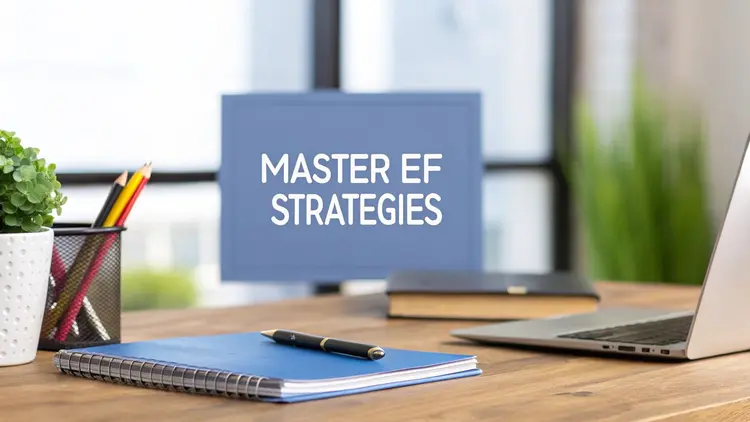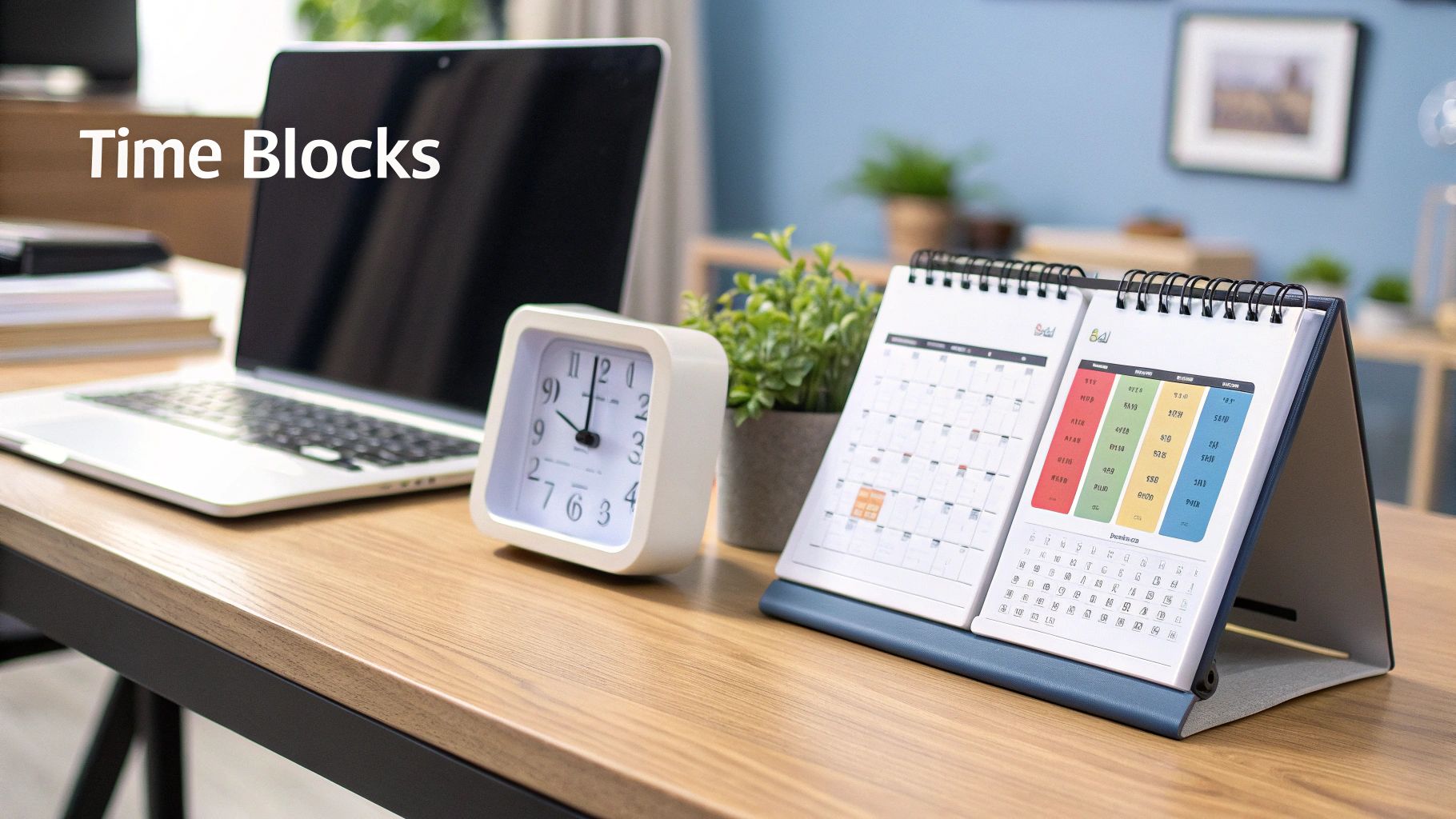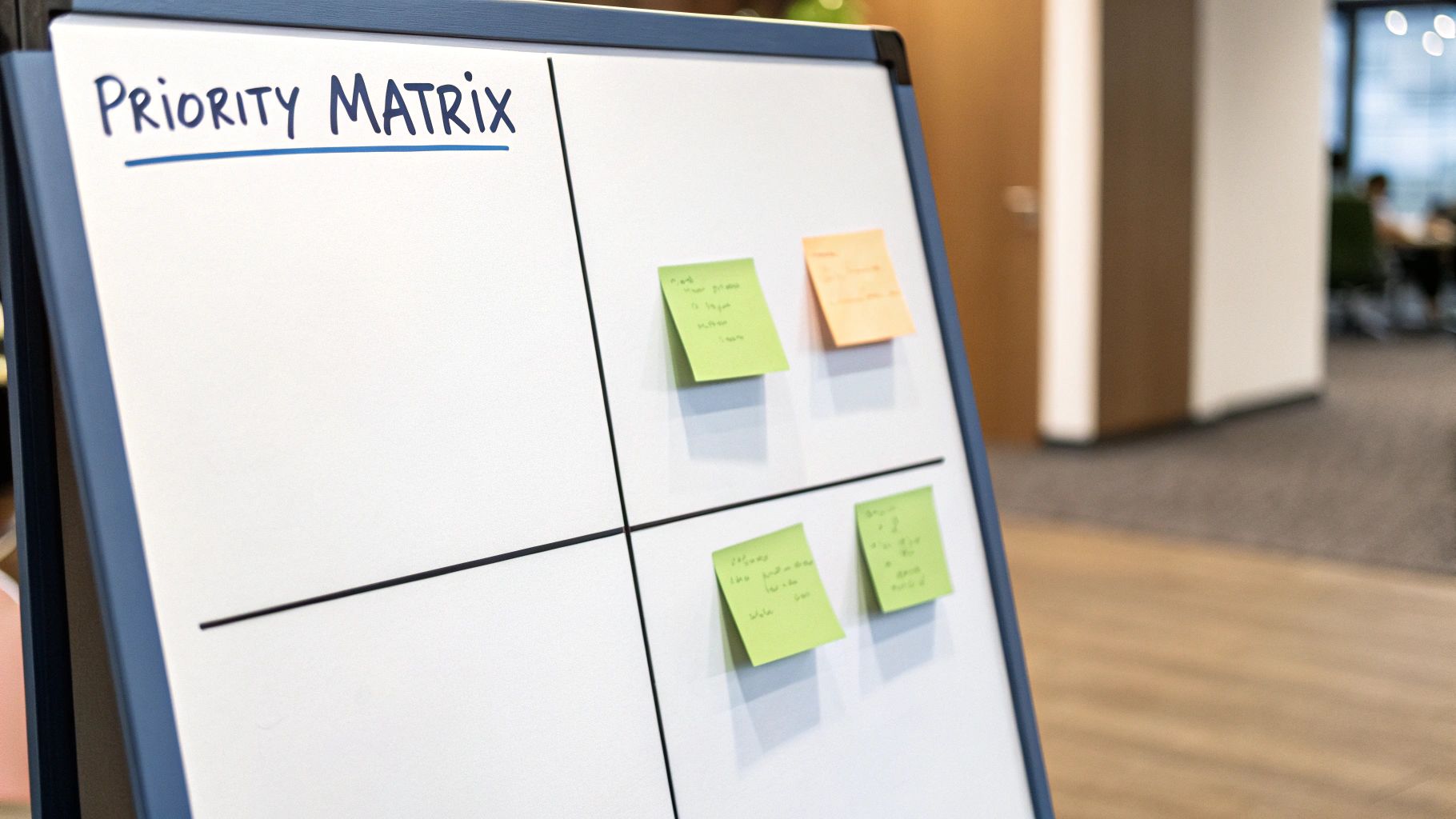Ready to conquer 2025?
Feeling swamped by a never-ending stream of information, deadlines, and tasks? You’re definitely not the only one. Managing multiple projects, staying focused, and reaching peak productivity can feel overwhelming in our fast-paced world. The secret to unlocking your potential? Mastering your executive functions.
These essential cognitive skills are the driving force behind success in both your personal and professional life. They encompass everything from planning and prioritizing to starting tasks and managing your emotions.
Our understanding of these mental processes has grown tremendously, from the groundbreaking work of psychologists like Alexander Luria, who studied the brain’s frontal lobes, to today’s applications of cognitive behavioral therapy (CBT). What was once a relatively niche area of research is now a cornerstone of productivity and personal growth, providing invaluable tools for handling the challenges of modern living.

Effective executive function strategies recognize that we’re not machines. They emphasize flexibility, acknowledge the significance of both mental and physical well-being, and utilize external tools to lighten our cognitive load.
This guide delves into 10 practical, evidence-based strategies to boost your executive functions and help you conquer 2025. Whether you’re an entrepreneur with ADD looking to improve focus, a content creator battling distractions, a solo business owner juggling multiple roles, a bullet journal enthusiast craving structure, or simply someone seeking practical productivity tips, you’ll find techniques to streamline your workflow, sharpen your focus, and achieve your goals more easily. Get ready to transform how you work and live, from simple adjustments to structured systems, and unlock your full potential in the coming year.
1. Time Blocking
Do you ever feel like the day just disappears, leaving you wondering where the time went? This can be especially frustrating for entrepreneurs, solo business owners, and content creators. If you’re looking to regain control of your schedule and boost your productivity, time blocking might be just the solution. This technique involves dividing your day into specific blocks of time, each dedicated to a particular task or activity. Think of it as a personalized daily roadmap, guiding you to better time management, reduced decision fatigue, and laser-sharp focus.

Time blocking’s structured approach to tasks encourages proactive scheduling instead of reactive scrambling. By pre-allocating your time, you minimize context switching—that productivity killer where you constantly jump between different tasks. You’ll also proactively combat procrastination. Instead of reacting to incoming demands, you’ll be intentionally directing your day.
Features and Benefits
Here are some key advantages of using time blocking:
- Dedicated Time Slots: Allocate specific timeframes for individual activities, ensuring everything from deep work to checking emails has its designated spot.
- Visual Representation: See your entire day laid out, giving you a clear overview of how your time is allocated. This visual structure can be especially helpful for those who benefit from clear visual cues.
- Reduced Decision Fatigue: Pre-planning your day eliminates the constant need to decide what to do next, freeing up mental energy for more important tasks.
- Increased Focus: Minimize distractions and context switching, allowing you to fully concentrate on tasks and achieve a state of flow.
- Accountability: Making explicit time commitments creates a sense of accountability, encouraging you to stick to your schedule.
Pros and Cons of Time Blocking
Let’s weigh the advantages and disadvantages:
Pros:
- Reduces decision fatigue
- Increases focus
- Creates accountability
- Helps visualize time usage
- Builds routine and consistency
Cons:
- Can feel rigid
- Requires regular adjustments
- Can be challenging with unexpected tasks
- Has an initial learning curve for accurate time estimation
Real-World Examples and Further Reading
Cal Newport, author of “Deep Work,” advocates time blocking for focused work sessions. Even high-profile figures like Elon Musk and Microsoft CEO Satya Nadella use this technique. Musk reportedly schedules his day in 5-minute increments, while Nadella prioritizes reflection time each morning. For more productivity tips, check out this helpful article: 4 Steps to Leverage Time & Increase Productivity.
Tips for Implementing Time Blocking
Ready to give time blocking a try? Here are some tips to get you started:
- Start Small: Begin by blocking just 2-3 hours per day and gradually increase as you become more comfortable.
- Buffer Time: Include short breaks between blocks for transitions and unexpected interruptions.
- Regular Review: Weekly review and adjustment are essential for optimizing your time blocks.
- Choose Your Tools: Utilize digital calendar apps, physical planners, or bullet journals – whatever works best for your personal style.
- Include Essential Blocks: Don’t forget to schedule time for breaks, reflection, and those inevitable unexpected issues.
Time blocking is a valuable tool for gaining control of your schedule, enhancing focus, and boosting productivity. By adopting this strategy, you’ll be well on your way to achieving your goals, whether you’re a busy entrepreneur, a dedicated content creator, or simply seeking a more organized and fulfilling life.
2. Pomodoro Technique
Feeling swamped with tasks? Procrastination creeping in? The Pomodoro Technique might just be the solution you’ve been searching for. Developed by Francesco Cirillo in the late 1980s, this time management method uses a timer to break your work into intervals, typically 25 minutes long, separated by short breaks. It’s a simple but surprisingly effective way to enhance focus and minimize distractions.

How It Works
The Pomodoro Technique is built around a few key principles:
- Fixed Work Intervals: These are your “pomodoros,” typically 25 minutes of focused work.
- Short Breaks: After each pomodoro, take a 5-minute break to clear your head.
- Longer Breaks: After every four pomodoros, enjoy a longer break of 15-30 minutes.
- External Time Tracking: Use a timer so you don’t have to worry about keeping track of time yourself.
Why It’s Effective
The Pomodoro Technique offers a range of benefits for entrepreneurs, content creators, and anyone looking to improve their focus:
- Manageable Chunks: Facing a large project can feel overwhelming. Breaking it down into 25-minute chunks makes it much less daunting.
- Reduced Mental Fatigue: Regular breaks help prevent burnout and keep you focused for longer.
- Combats Procrastination: The structured time blocks and short bursts of work help you overcome inertia and get started.
- Frees Up Mental Space: Letting a timer manage your time frees up mental resources for the task at hand.
Pros and Cons
Let’s take a look at the upsides and downsides:
- Pros: Manageable work intervals, regular breaks to avoid mental fatigue, reduces feelings of being overwhelmed, external timing reduces cognitive load, and promotes a sense of urgency.
- Cons: Fixed intervals might not suit all tasks, can interrupt your flow state, might need adjustments for different work types, and transitions between tasks can sometimes be tricky.
Real-World Examples
The Pomodoro Technique is used across a variety of professions:
- Software Developers: Many development teams use Pomodoro for coding sprints to improve productivity and minimize errors.
- Students: Breaking study material into Pomodoro intervals helps students maintain concentration and absorb information effectively.
- Writers: Writers can use this technique to achieve consistent daily word counts and overcome writer’s block.
Tips for Implementation
Here are a few tips to get you started:
- Adapt the Intervals: Experiment with work and break durations to find what suits your focus best. A 45/15 minute split works well for some.
- Use a Physical Timer: A kitchen timer or dedicated Pomodoro timer can be less distracting than a phone app.
- Plan Your Pomodoros: Decide what you’ll work on before starting each interval.
- Track Your Progress: Keeping a log of completed pomodoros can be a great motivator.
- Handle Interruptions: If interrupted, either end the pomodoro early or politely postpone the interruption.
From Kitchen Timer to Productivity Powerhouse
Francesco Cirillo initially used a tomato-shaped kitchen timer (pomodoro is Italian for tomato) to develop this technique. It gained popularity through productivity experts like Tim Ferriss who have championed its effectiveness. Want to learn more about beating procrastination? Check out Our guide on how to avoid procrastination. This simple method has earned its place on this list for its practical approach to improving focus, managing time, and conquering procrastination.
3. Task Prioritization Matrices
Feeling swamped by an overflowing to-do list? Task prioritization matrices can be a game-changer. These visual tools help you assess and rank tasks based on factors like urgency, importance, effort, and impact. This organized approach to decision-making directly addresses the challenges of planning and prioritizing, a common struggle for those with executive function differences. By establishing a clear method for deciding what to tackle when, you take charge of your workload and minimize decision fatigue.

A prime example is the Eisenhower Matrix, made famous by Dwight D. Eisenhower and later by Stephen Covey in his book 7 Habits of Highly Effective People. This matrix categorizes tasks into four quadrants: urgent/important, important/not urgent, urgent/not important, and not important/not urgent. This straightforward visual helps separate truly important tasks from mere distractions. Beyond the Eisenhower Matrix, other methods like the RICE scoring method (Reach, Impact, Confidence, and Effort) are commonly used by product teams for prioritizing features. You might also find our guide on maximizing your team’s potential with task management systems helpful.
Key Features and Benefits
- Visual Organization: See your tasks clearly displayed according to your chosen criteria, providing a better overview of your workload and highlighting key priorities.
- Clear Decision-Making Framework: Eliminate the uncertainty of what to work on next. The matrix offers a structured approach for task selection.
- Reduced Cognitive Load: Simplify decision-making and free up mental resources for the actual work.
- Distinguish Between Important vs. Distracting Tasks: Develop the skill of recognizing and minimizing or delegating less critical activities.
Pros
- Objective prioritization criteria
- Less decision fatigue
- Easier to identify tasks for delegation or elimination
- Visual representation of your workload
- Turns implicit thinking into explicit plans
Cons
- Potential oversimplification of complex projects
- Requires consistent upkeep
- Some tasks may not fit neatly into categories
- Initial time investment for setup
Practical Tips for Implementation
- Daily Review: Refresh your matrix at the same time every day (e.g., first thing in the morning) to maintain its accuracy and relevance.
- Honest Assessment: Be realistic about what’s truly urgent versus simply demanding. A ringing phone is often demanding but rarely genuinely urgent.
- Limit “Urgent & Important”: Avoid overloading this quadrant to prevent feeling overwhelmed. Keep it manageable.
- Color Coding: Use distinct colors for different categories to improve visual clarity and organization.
- Start Simple: Begin with a single prioritization criterion (e.g., importance) before adding more complexity.
Task prioritization matrices are incredibly valuable tools for entrepreneurs, solopreneurs, content creators, and anyone seeking better productivity and focus. By implementing these strategies, you can regain command of your time and energy and get closer to reaching your goals.
4. Cognitive Behavioral Coaching
Do you ever find yourself staring blankly at your computer, knowing you should be working, but just can’t seem to get started? Or maybe you’re easily sidetracked by social media or that enticing pile of laundry? These common struggles often stem from our thoughts and behaviors, and Cognitive Behavioral Coaching (CBC) can help. CBC uses the principles of Cognitive Behavioral Therapy (CBT) to improve executive function, the mental skills that help us plan, focus, and manage our time.
This structured approach helps you understand the link between your thoughts and actions, especially when it comes to starting tasks, staying focused, and managing emotions. These are all key aspects of executive function, and strengthening them can significantly boost your productivity.
CBC begins by identifying negative or unhelpful thoughts that might be holding you back. For example, thoughts like, “I’ll never get this done,” or “I’m not smart enough for this project,” can drain your motivation and lead to procrastination. Through CBC, you’ll learn to reframe these thoughts into something more positive and realistic. Instead of “I’ll never get this done,” you might think, “This project is challenging, but I can break it down into smaller, more manageable tasks.”
Implementation Intentions: Your Secret Weapon
One powerful technique in CBC is the development of implementation intentions, sometimes called “if-then” planning. This involves creating specific plans for handling difficult situations. For example, “If I start to feel overwhelmed by my to-do list, then I will take a five-minute break and then prioritize the top three tasks.” This proactive planning helps you stay on track and avoid impulsive reactions.
Beyond Thoughts: Actionable Change
CBC goes beyond simply identifying negative thoughts; it focuses on making real behavioral changes. You’ll learn strategies for improving time management, organization, and task completion. You might even conduct behavioral experiments to test your assumptions about your productivity. For instance, if you believe you’re a night owl, you could experiment with working earlier in the day to see if it actually improves your output.
Features of CBC:
- Identifying negative thoughts that affect productivity
- Restructuring limiting beliefs
- Developing implementation intentions (if-then planning)
- Focusing on actionable behavioral changes
Pros:
- Addresses the underlying thought patterns that hinder executive function
- Evidence-based approach
- Provides cognitive and behavioral tools
- Customizable to individual needs
- Creates lasting change
Cons:
- May require professional guidance
- Can take time to see significant improvements
- Requires consistent practice and self-awareness
- Can be uncomfortable at times
Examples of CBC in Action:
- Executive coaching programs
- Corporate wellness programs
- Educational settings
Tips for Implementing CBC:
- Track your thoughts when facing challenges.
- Create specific implementation intentions (“If X, then Y”).
- Challenge negative thoughts.
- Conduct behavioral experiments.
- Consider working with a trained coach.
Pioneers like Dr. Aaron Beck, the founder of CBT, and Dr. Russell Ramsay have helped popularize CBC. David Burns, author of Feeling Good, has also made significant contributions to the field. For busy entrepreneurs, solopreneurs, and content creators, the constant pressure to stay productive can be overwhelming. You might find this article helpful: How to Reset a Stressed Life. CBC offers a powerful, evidence-based way to improve executive function by addressing the root causes of productivity challenges, paving the way for lasting positive change.
5. External Scaffolding Systems
Feeling overwhelmed? Like your brain’s juggling too many things at once? External scaffolding systems can help. These are basically external tools and frameworks that bring structure to your life, compensating for any executive function weaknesses you might have. Think physical organizers, digital apps, visual reminders—even just tweaking your environment. They take the mental load off remembering tasks, managing time, and staying organized, freeing up your brainpower for more important things.
Instead of relying on your internal working memory (which can be unreliable!), you externalize these processes. A physical inbox for tasks, a digital calendar for appointments, color-coded folders for projects—these are all examples of external scaffolding in action. These systems can range from physical or digital organization tools to strategically placed visual cues and consistent routines. The goal is simple: to make life easier by moving mental effort outside your head.
This is especially helpful for entrepreneurs with ADD, solo business owners, content creators, or anyone juggling multiple responsibilities. Consistent routines and systems, facilitated by external scaffolding, become habits that lessen your dependence on fluctuating motivation. Visual cues placed strategically help you avoid distractions and stay focused. A Kanban board, for example, is a great illustration of visual management as an external scaffold. Similarly, educational settings often use visual schedules and structured environments to help students facing executive function challenges.
The benefits are many. Externalizing reduces cognitive load, provides reliable structure even when you’re not feeling your best, and can be adapted to your individual needs. Think of the Getting Things Done (GTD) method by David Allen—a complete external system helping you capture, clarify, organize, reflect on, and engage with tasks. Or consider the Bullet Journal method, made popular by Ryder Carroll, which provides a flexible and personalized system for organization. Check out this helpful resource: How to Organize Your Life with Bullet Journal.
Of course, there are potential drawbacks. Setting up these systems takes time and effort upfront. They also need regular upkeep to stay effective. Some people might become overly reliant on the external systems, or resist using them entirely. But the advantages usually outweigh the disadvantages, particularly for those struggling with executive function. And often, a well-designed system benefits everyone in a shared environment—a universal design approach.
Tips for Implementation
- Start small: Don’t try to change everything at once. Begin with one system, get comfortable with it, and gradually add more.
- Visual cues are key: Place visual reminders where they’ll be most effective, prompting you at decision points.
- Create homes: Designate specific physical or digital places for items you use often.
- Keep it simple: The easier a system is to use and maintain, the more likely you’ll stick with it.
- Regular reviews: Schedule regular check-ins to make sure your systems are still working well for you.
External scaffolding systems are valuable because they offer a tangible, practical way to manage the struggles of executive dysfunction. They help you control your cognitive processes, create more structure, and ultimately, free up mental space for what truly matters. The work of Dr. Russell Barkley, a prominent researcher in executive function, emphasizes the importance and effectiveness of these external supports.
6. Implementation Intentions: Your Secret Weapon Against Procrastination
Do you ever find yourself wanting to do something, but never actually getting around to it? This is a common struggle, and Implementation Intentions are a great tool to combat this. Think of them as pre-planned responses to specific situations, designed to sidestep that tricky decision-making process that often derails our best-laid plans. This strategy is valuable because it’s a simple, yet effective, way to bridge the gap between thinking and doing.
Implementation Intentions use a straightforward “if-then” format. “If this happens, then I will do that.” By deciding your response to a specific trigger ahead of time, you essentially put the behavior on autopilot, reducing the need for willpower and in-the-moment decisions.
How Does It Work?
This strategy works by connecting cues in your environment with predetermined responses. For example, instead of vaguely saying you’ll “exercise more,” you could create an implementation intention like, “If it’s 7am on a weekday, then I will put on my running shoes and go for a 20-minute jog.” The 7am alarm becomes your cue, automatically triggering the desired response. By removing the need to decide whether to exercise at that moment, you significantly increase your chances of actually doing it.
Features and Benefits
- Specific “if-then” planning: This easy format simplifies the process.
- Connects cues with responses: Links specific situations with predetermined actions.
- Creates automatic behavioral patterns: Turns desired actions into automatic responses.
- Reduces decision fatigue: Lessens the mental effort of making choices in the moment.
Pros
- Proven Effectiveness: Research by Dr. Peter Gollwitzer, the originator of the concept, shows significant improvements in follow-through.
- Reduces Effort: Makes it easier to start and continue desired behaviors.
- Overcomes Procrastination: Helps bypass the initial resistance to starting tasks.
- Wide Applicability: Useful for everything from health habits to productivity.
- Easy to Learn: The “if-then” format is simple and straightforward.
Cons
- Requires Planning: You need to identify relevant triggers and responses.
- May Need Refinement: Finding effective “if-then” pairings may take some trial and error.
- Specificity is Key: Vague intentions won’t work as well.
- Requires Practice: It takes consistent practice to make the behavior automatic.
Real-World Examples
- Content Creators: “If I finish my morning coffee, then I will write for one hour.”
- Entrepreneurs with ADD: “If I feel overwhelmed, then I will take a 5-minute break and practice deep breathing.”
- Digital Declutterers: “If I download a new app, then I will delete two old ones.”
- Productivity Hack Seekers: “If it’s Friday afternoon, then I will review my accomplishments for the week and plan for the next.”
Tips for Implementation
- Be Specific: “If it’s lunchtime” isn’t as effective as “If it’s 12:30pm.”
- Start Small: Begin with 2-3 implementation intentions and add more as they become habit.
- Leverage Existing Habits: Connect new behaviors to existing routines.
- Write It Down: Make them concrete by writing them down.
- Review Regularly: Keep your implementation intentions visible and review them often.
From Research to Popular Books
While Dr. Peter Gollwitzer established the foundation for Implementation Intentions, authors like James Clear (Atomic Habits) and BJ Fogg (Tiny Habits) have popularized similar ideas, further demonstrating their value in personal productivity and habit formation.
By strategically connecting specific cues with desired responses, Implementation Intentions offer a valuable tool for overcoming procrastination and reaching your goals. Try this strategy and see how your intentions turn into consistent action.
7. Working Memory Supports
Ever feel like your brain is overflowing? For entrepreneurs, solopreneurs, content creators, and anyone striving for peak productivity, a strong working memory is essential. What happens when your working memory needs a little boost? That’s where working memory supports step in. These helpful techniques and tools act as an extension of your brain, assisting you in managing information overload. This frees up your cognitive resources for the more demanding tasks in your day. This is important for everyone, but especially for those with ADD who often face working memory challenges.
Working memory supports help fill in the gaps where our brains sometimes struggle to temporarily hold and manipulate information. Think of them as an external hard drive for your mind. They provide a place to offload information, reducing strain on your working memory and making sure crucial details don’t get lost. This can be a lifesaver when dealing with complex projects, brainstorming new ideas, or just trying to remember that brilliant idea you had in the shower.
Features and Benefits
Here are some common features and benefits you’ll find with working memory supports:
- External Memory Storage Systems: These can be as basic as using a pen and paper, a dedicated notebook, or powerful digital tools like Notion, Obsidian, or even a well-organized Google Docs system. They offer a safe place for your thoughts, ideas, and to-do lists, letting your mind focus on the task at hand.
- Information Chunking: Breaking down complex information into smaller, more digestible pieces makes it easier to process and remember. Think about phone numbers or credit card numbers – they’re grouped for easier recall.
- Visualization Methods: Mind mapping, sketching, and other visual techniques use the strength of visual memory. They make abstract ideas more concrete and easier to remember. This is especially helpful for visual thinkers and creative projects.
- Systematic Note-Taking: Methods like the Cornell note-taking system offer a structured way to capture and review information, making it easier to synthesize and recall later.
Pros and Cons
Like anything, working memory supports have their pros and cons.
Pros:
- Reduces cognitive load, making it easier to handle complex tasks
- Prevents important details from being forgotten
- Shifts focus from remembering to processing, boosting productivity and creativity
- Particularly beneficial for sequential tasks and instructions
- Supports working memory challenges, common for those with ADHD
Cons:
- Different techniques work better for different people and situations
- Some methods require practice to fully master
- Can feel cumbersome in fast-paced environments if not implemented effectively
- Digital tools can sometimes become distractions
Real-World Examples
Let’s see how these techniques can be used in everyday life:
- A student uses Cornell notes to prepare for exams, organizing key concepts and questions.
- An entrepreneur builds a “second brain” in Notion to manage projects, track progress, and connect ideas.
- A content creator uses a mind map to brainstorm blog post ideas, visually exploring and generating interconnected concepts.
Evolution and Popularity
Working memory support techniques have grown from simple note-taking to sophisticated digital systems. The rise of personal knowledge management systems, championed by people like Sonke Ahrens (How to Take Smart Notes), Niklas Luhmann (Zettelkasten method), and Tiago Forte (Building a Second Brain methodology), has made these techniques even more popular, especially for knowledge workers. Tony Buzan’s work on Mind Mapping also helped make visual thinking tools widely used.
Tips for Implementation
Here are some tips to get started:
- Externalize Immediately: Don’t try to keep everything in your head. Write, type, or record it as soon as possible.
- Choose Your Modality: Experiment with different methods (visual, auditory, kinesthetic) to find what works for your learning style.
- Regular Review: Go back over your notes regularly to reinforce your learning.
- Create Templates: Develop templates for recurring tasks to simplify your workflow.
- Practice Chunking: Group related information together into smaller, manageable units.
Working memory supports are invaluable for anyone overwhelmed by information. By using these techniques and tools, you can clear your mental space, improve productivity, and reach your full creative potential. They are a must-have in any productivity toolkit, especially for entrepreneurs, content creators, and anyone looking to improve their cognitive performance.
8. Body-Based Regulation Strategies: Ground Yourself for Greater Focus
Ever feel like your thoughts are scattered, bouncing around your head like a ping-pong ball? Body-based regulation strategies offer practical tools to regain control and sharpen your executive function. These techniques recognize the strong link between your physical state and your mental abilities, using the power of your body to improve focus, working memory, and attention management.https://www.youtube.com/embed/gIyyHBUPRZs
Executive function isn’t just a mental exercise; it’s deeply connected to your physical well-being. Research shows that physical interventions can significantly improve cognitive control. This makes body-based regulation essential for anyone seeking peak productivity, particularly entrepreneurs, content creators, and those managing multiple projects.
From exercise and movement breaks to breathwork, meditation, and sensory regulation techniques, there are various ways to ground yourself and find mental clarity. Even optimizing sleep and nutrition plays a key role. Think of it as giving your brain the best fuel and rest it needs to perform at its highest level.
Features and Benefits
Here’s a breakdown of some effective body-based regulation strategies:
- Physical Activity Interventions: Short bursts of exercise or even quick movement breaks can refresh your brain, increasing blood flow and boosting cognitive function.
- Breathwork and Meditation Practices: Techniques like box breathing can quickly calm your nervous system and sharpen your focus, especially helpful when switching tasks or during stressful moments. Mindfulness meditation cultivates a deeper awareness of your thoughts and feelings, giving you greater control over your mental state.
- Sensory Regulation Techniques: Experimenting with sensory inputs (like fidget toys, weighted blankets, or specific scents) can help you find what grounds you in the present moment and promotes a sense of calm.
- Sleep Optimization Strategies: Prioritizing regular, high-quality sleep is vital for cognitive recovery and optimal executive function.
- Nutrition Approaches: Maintaining steady glucose levels through balanced eating habits prevents energy crashes and helps sustain focus throughout the day.
Pros and Cons
Like any approach, body-based regulation has its advantages and disadvantages:
Pros:
- Targets the underlying physiological factors affecting executive function.
- Can offer immediate boosts in focus and regulation.
- Supported by growing scientific research.
- Provides benefits beyond executive function, such as improved mood and stress reduction.
- Many techniques can be easily incorporated into different environments.
Cons:
- Requires ongoing practice for lasting results.
- Individual responses differ, so experimentation is key to finding what works best.
- Some approaches, like meditation, might require dedicated time.
- Professional guidance could be helpful for optimal implementation in certain situations.
Real-World Examples
Here are some examples of body-based regulation in action:
- Schools incorporating movement breaks between classes to enhance student attention and engagement.
- Corporate wellness programs offering mindfulness and meditation training to reduce stress and boost productivity.
- Healthcare settings using sensory regulation techniques to assist patients with executive dysfunction.
Practical Tips for Implementation
Want to give body-based regulation a try? Here are a few tips:
- Move Your Body: Include short movement breaks (5-10 minutes) before tackling challenging cognitive tasks or during extended periods of sitting.
- Breathe Deeply: Practice simple breathwork exercises like box breathing (inhale for 4, hold for 4, exhale for 4, hold for 4) during transitions or stressful times.
- Sensory Exploration: Experiment with different sensory inputs to find what helps you feel centered and focused.
- Prioritize Sleep: Aim for 7-9 hours of quality sleep each night.
- Mindful Eating: Be aware of the timing and composition of your meals and snacks to maintain stable blood sugar levels.
The Rise of Body-Based Regulation
The growing understanding of the mind-body connection has increased the popularity of these strategies. The work of researchers like Dr. John Ratey (author of “Spark: The Revolutionary New Science of Exercise and the Brain“) and Dr. Bessel van der Kolk (advocate for body-based approaches to trauma recovery) has highlighted the profound effects of physical interventions on cognitive function and emotional regulation. Mindfulness practices, popularized by figures like Jon Kabat-Zinn, have further contributed to the wider acceptance of these techniques.
Body-based regulation strategies are valuable additions to any executive function toolkit. By incorporating these practices, you’re not just improving focus and productivity; you’re building a more resilient and grounded approach to managing your mental energy. This is especially helpful for entrepreneurs, solo business owners, and content creators who often face demanding workloads and need to maintain peak cognitive performance.
9. Environmental Modifications
Your environment plays a surprisingly big role in how well your brain functions, especially those executive functions like focusing, planning, and getting things done. Think about it: a cluttered, noisy room can feel overwhelming, making it hard to concentrate. But a calm, organized space? That’s like a breath of fresh air for your mind. Environmental modifications are all about consciously shaping your surroundings to minimize distractions and help you perform at your best. It’s recognizing that our brains don’t work in isolation; they’re constantly interacting with the world around us. This is why optimizing your workspace is so important for entrepreneurs with ADD, solopreneurs, content creators, and anyone looking to boost productivity.
Why This Matters for You
If you’re juggling multiple projects, constantly battling distractions, or struggling to even start a task, environmental modifications can be a game-changer. By strategically tweaking your physical and digital spaces, you create an external support system for your brain. This isn’t just about making things look nice; it’s about designing an environment that actually helps you get things done.
Features and Benefits
Here’s how changing your environment can make a difference:
- Distraction Reduction: Set up some boundaries, both physical and digital. Think noise-canceling headphones, website blockers like Freedom, and designated “no-phone” zones. Minimizing distractions frees up your brainpower to focus on what matters.
- Strategic Organization: A tidy workspace, both physically and digitally, reduces the mental effort needed to find what you need. This frees up mental space for more important tasks.
- Visual Cueing: Visual reminders, color-coded systems, and clear labels can be surprisingly helpful for starting and finishing tasks. They act as external prompts, guiding your focus and taking some of the pressure off your memory.
- Sensory Optimization: Experiment with lighting, sound, and temperature to find what works best for you. Some people thrive in bright, cool environments, while others prefer things warmer and more subdued.
- Context-Specific Work Zones: Designate specific areas for different types of work. This helps your brain switch gears more easily between tasks and stay focused on the job at hand.
Pros and Cons
Let’s take a look at the advantages and disadvantages:
| Pros | Cons |
|---|---|
| Reduces cognitive load | May require negotiation in shared spaces |
| Creates external cues for tasks | Some modifications require investment |
| Customizable to individual needs | Individual needs vary significantly |
| Often benefits everyone around you | Requires ongoing maintenance and updating |
| Many modifications are low-cost |
Real-World Examples
Environmental modifications are already making a difference in many settings:
- Google’s Workspace Designs: Google has explored different workspace designs to optimize for different types of work, recognizing the impact of environment on productivity and creativity.
- Educational Settings: Many schools are using flexible seating, sensory considerations, and quiet zones to help students learn more effectively, based on the Universal Design for Learning framework.
- Home Office Setups: Creating a dedicated workspace at home, minimizing distractions, and using visual supports can dramatically improve productivity.
Tips for Implementation
Ready to get started? Here are some simple steps:
- Distraction Audit: What’s your biggest distraction? Noise? Clutter? Notifications? Identify the culprit and start tackling it.
- Visual Boundaries: Create clear distinctions between different areas in your workspace for different activities.
- Environmental Cues: Try using specific music, lighting, or scents to signal transitions between different work modes.
- Visual Reminders: Strategically placed to-do lists and reminders can keep you on track.
- Sensory Needs: Invest in tools that cater to your sensory preferences, like noise-canceling headphones or specific lighting.
Origins and Popularity
The idea of optimizing your environment for cognitive performance has gained traction thanks to people like Cal Newport, author of Deep Work, and Marie Kondo, known for her organizational methods. The Universal Design for Learning framework has also played a key role. By consciously shaping your environment, you can create a powerful support system for your brain. This is about more than just getting organized; it’s about creating a space that helps you focus, be creative, and achieve your goals.
10. Metacognitive Strategies: Become Your Own Executive Function Coach
Metacognition is simply “thinking about thinking.” It’s about understanding how your own brain works. When you apply this to executive function, you become your own brain’s coach. You learn to recognize, manage, and improve how you plan, focus, and get things done. This is incredibly helpful for boosting productivity and self-management, especially for entrepreneurs, solo business owners, content creators, and anyone juggling multiple responsibilities.
Imagine knowing exactly when your focus starts to drift, or sensing when you’re about to feel overwhelmed. Metacognitive strategies give you this power. You can identify your strengths and weaknesses, predict challenges, and use the right strategies at the right time. You’re essentially “executing the executive functions” better.
How It Works
Metacognition involves a few key elements:
- Self-Monitoring: Regularly checking in with yourself. Ask yourself questions like, “How focused am I?” or “Am I starting to feel overwhelmed?”
- Reflection: After finishing a task or project, evaluate how well your strategies worked. “Was that approach effective? What could I have done differently?”
- Personalized Strategy Inventory: Build your own toolbox of strategies. This might include time-blocking for focused work or using the Pomodoro Technique for managing procrastination.
- Structured Problem-Solving: Use frameworks to break down complex tasks and identify potential roadblocks.
- Regular Review: Continuously look back and adjust your approach based on what you’ve learned.
Why This Matters (Especially For You)
For entrepreneurs, content creators, and solopreneurs, strong executive function is essential for success. Metacognitive strategies provide a sustainable, personalized approach to handling the daily demands of these roles. Whether you’re dealing with digital distractions, looking for productivity tips, or trying to stay focused on your goals, metacognition helps you build the self-regulation skills you need for the long haul.
Pros
- Long-Term Self-Regulation: You build lasting skills for managing your attention, emotions, and impulses.
- Flexibility: You’ll have a variety of strategies to adapt to different situations.
- Transferable Skills: The self-awareness you develop helps you in other areas of your life.
- Early Warning System: You’ll recognize when your executive function is struggling before things get out of hand.
- Personalized Approach: Your strategy toolbox evolves to become increasingly tailored to your unique needs.
Cons
- Time Investment: Developing these skills takes consistent practice and reflection.
- Delayed Gratification: The benefits are usually gradual, not immediate.
- Difficult During Stress: It can be tough to use these strategies when you’re already overwhelmed or tired.
Real-World Examples
- A blogger keeps a strategy journal to track which writing environments (coffee shop versus home office) help them be most productive.
- An entrepreneur with ADD uses the Pomodoro Technique and regular breaks to stay focused during deep work.
- A solo business owner uses a structured problem-solving framework to break down a large project into smaller steps, predicting potential challenges and creating backup plans.
Practical Tips For Implementation
- Strategy Journal: Write down what works and what doesn’t in different situations.
- Scheduled Reviews: Set aside time to regularly reflect on how well your strategies are working.
- Self-Monitoring Prompts: Use reminders like, “How’s my focus?” or “Is this the best way to do this?”
- Personal Rating Scales: Create scales to assess your current state (e.g., focus, energy, motivation).
- “If-Then” Guidelines: Develop rules for when to change strategies (e.g., “If I can’t focus after 25 minutes, then I’ll take a 5-minute break”).
Influential Figures
Experts like Dr. Russell Barkley (executive function and self-regulation), Carol Dweck (growth mindset), and many educational psychologists (“learning to learn” frameworks) have all contributed to the popularity of metacognitive strategies.
By using metacognitive strategies, you’re not just adopting new tools; you’re developing a mindset of continuous self-improvement. You’re giving yourself the skills to navigate the challenges of modern life and achieve your goals with more efficiency and control.
10-Point Executive Strategy Comparison
| Strategy | 🔄 Complexity | ⚡ Resources | 📊 Outcomes | 💡 Ideal Use Cases | ⭐ Key Advantages |
|---|---|---|---|---|---|
| Time Blocking | Moderate – requires planning and regular adjustments | Digital calendars, paper planners, dedicated apps | Improved focus, reduced decision fatigue, structured scheduling | Routine work, structured environments | Clear accountability and routine building |
| Pomodoro Technique | Low to Moderate – fixed intervals with potential tweaks | Timers (physical or digital), productivity apps | Manageable work segments with periodic breaks; reduced burnout | Tasks needing sustained focus, study sessions | Breaks work into digestible periods to beat procrastination |
| Task Prioritization Matrices | Moderate to High – setup and continuous updating needed | Visual charts, digital tools, paper frameworks | Enhanced task ranking and decision-making; minimized overwhelm | Complex projects, strategic planning sessions | Provides objective criteria for task selection |
| Cognitive Behavioral Coaching | High – often requires professional guidance and prolonged practice | Professional coaching, structured curricula | Lasting behavioral change and improved cognitive restructuring | Deep-seated executive function challenges | Targets underlying cognitive barriers for long-term improvement |
| External Scaffolding Systems | Moderate – initial setup with ongoing maintenance | Organizational tools, planners, digital apps | Offloads cognitive demands; improved organization and consistency | Environments needing external structure and reminders | Provides consistent external supports to reduce mental load |
| Implementation Intentions | Low – simple if-then planning | Written plans, self-generated cues | Enhanced follow-through and automated responses through pre-planning | Habit formation, bridging intention-action gaps | Simple, research-supported plan that automates responses |
| Working Memory Supports | Low to Moderate – may require familiarization with techniques | Note-taking systems, mnemonic devices, chunking methods | Improved retention, reduced overload of working memory | Sequential tasks, complex information processing | Compensates for working memory limitations efficiently |
| Body-Based Regulation Strategies | Moderate – involves physical/cognitive practice and consistency | Exercise routines, meditation guides, sensory tools | Immediate gains in focus and regulation, improved cognitive control | Situations needing quick stress relief and cognitive reset | Enhances executive function through physiological optimization |
| Environmental Modifications | Low to Moderate – initial setup with minimal ongoing maintenance | Physical changes, visual cues, digital boundaries | Reduced distractions and enhanced focus cues | Personal and shared workspaces requiring optimized environments | Cost-effective adaptations with broad cognitive impact |
| Metacognitive Strategies | High – demands regular self-reflection and practice | Journals, structured reflective frameworks, tracking tools | Increased self-awareness and adaptive regulation of executive functions | Long-term improvement and self-regulation enhancement | Builds lasting self-regulation skills through deliberate reflection |
What’s Your Executive Function Action Plan?
From time blocking and the Pomodoro Technique to cognitive behavioral coaching and metacognitive strategies, we’ve explored a wealth of tools to boost your executive function. The key takeaway? There’s no one-size-fits-all solution. It’s all about understanding the core principles – prioritizing, organizing, activating, focusing, regulating, and remembering – and finding what clicks for you. Experiment with time boxing, explore different prioritization methods like the Eisenhower Matrix (Urgent/Important), and consider how external systems, like visual timers or detailed to-do lists, can give you the structure you need to thrive.
Building sustainable habits is essential. Start small, concentrating on one or two strategies at a time. As you weave these practices into your daily routine, you’ll gain valuable self-awareness about your cognitive style and what truly fuels your focus and productivity. Remember that adapting is key. Regularly reflect on your progress, pinpoint any obstacles, and adjust your approach as needed.
The world of productivity and executive function support is always changing. We’re seeing a surge in personalized digital tools, AI-powered assistants, and a greater focus on incorporating mindfulness and body-based regulation techniques into our workflows. The future of productivity is about working smarter, not harder, by using technology and evidence-based strategies to maximize our cognitive potential.
Key Takeaways
- Personalization is Paramount: Discover what truly works for you.
- Start Small, Think Big: Build lasting habits step by step.
- Adapt and Evolve: Regularly review and refine your strategies.
- Embrace the Future: Explore new tools and techniques.
Feeling a bit lost in the sea of information and tools? Looking for a simpler way to manage your entrepreneurial journey, especially if you’re dealing with the unique challenges of ADD? Lorelei Web is here to help. Offering a personalized mix of practical advice, actionable strategies, and real-world insights, Lorelei Web helps entrepreneurs cut through the clutter and zero in on what truly matters. From mastering digital decluttering to harnessing the power of journaling and mind mapping, Lorelei Web equips you with the tools and knowledge to optimize your productivity, sharpen your focus, and achieve lasting success. Start your journey toward a more organized and fulfilling entrepreneurial life today!

Lorelei has been an online entrepreneur, marketer and writer since 2006. Her biggest passion is WordPress, which is why she switched to being a full-time blogger 20 years ago and hasn’t looked back since. With so many years of experience behind her, she is an expert in copywriting, SEO, marketing and business strategies.






